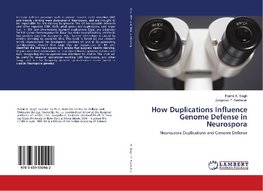
-
 Anglický jazyk
Anglický jazyk
How Duplications Influence Genome Defense in Neurospora
Autor: Parmit K. Singh
Genome defence processes such as repeat induced point mutation (RIP) and meiotic silencing were discovered in Neurospora, and are thought to be responsible for maintaining its genome free of transposable elements and other repeated DNA. Both, small gene-sized... Viac o knihe
Na objednávku
57.33 €
bežná cena: 63.70 €
O knihe
Genome defence processes such as repeat induced point mutation (RIP) and meiotic silencing were discovered in Neurospora, and are thought to be responsible for maintaining its genome free of transposable elements and other repeated DNA. Both, small gene-sized duplications, and larger (i.e., > 100 kbp) chromosome segment duplications (Dps), are substrates for RIP. Crosses heterozygous for large Dps make normal looking perithecia but produce vary few ascospores. This, ¿barren¿ phenotype is caused by meiotic silencing by unpaired DNA. This book is based on our research which characterised the breakpoint junctions of several Dp¿generating translocations, showed that large Dps are suppressors of RIP, and identified the first Neurospora wild strains that suppress meiotic silencing. It gives important information on how Dps influence genome defence and how recognizing this has opened new directions for studies. The book will be useful for research laboratories working with Neurospora, and other fungi, and also for University students to understand recent trends in classical Neurospora genetics.
- Vydavateľstvo: LAP LAMBERT Academic Publishing
- Rok vydania: 2018
- Formát: Paperback
- Rozmer: 220 x 150 mm
- Jazyk: Anglický jazyk
- ISBN: 9783659550942












